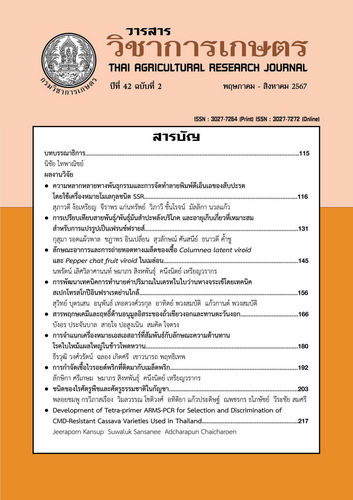สารพฤกษเคมีและฤทธิ์ต้านอนุมูลอิสระของถั่วเขียวงอกและทานตะวันงอก
DOI:
https://doi.org/10.14456/thaidoa-agres.2024.14คำสำคัญ:
ถั่วเขียวงอก, ทานตะวันงอก, สารพฤกษเคมี, ฤทธิ์ต้านอนุมูลอิสระบทคัดย่อ
ถั่วเขียวและทานตะวันเป็นพืชที่นิยมรับประทานเป็นผักในระยะต้นกำลังงอก ทั้งถั่วเขียวงอกและทานตะวันงอกมีสารที่มีประโยชน์เหมาะที่จะนำไปพัฒนาเป็นผลิตภัณฑ์อาหารอาหารเพื่อสุขภาพ การทดลองนี้จึงมีวัตถุประสงค์เพื่อเปรียบเทียบผลของการงอกต่อสารพฤกษเคมีและฤทธิ์ต้านอนุมูลอิสระของถั่วเขียวงอก (Vigna radiata (L.) Wilczek) พันธุ์ชัยนาท84-1 และทานตะวันงอก (Helianthus annuus L.) พันธุ์ลูกผสมอะควอร่า6 เพื่อหาระยะการงอกที่เหมาะสมในการใช้เป็นวัตถุดิบในการผลิตอาหารเพื่อสุขภาพ ทำการทดลองโดยให้เมล็ดถั่วเขียวและทานตะวันดูดซับน้ำแล้ว นำมาเพาะเมล็ด 0 - 6 วัน เพื่อทำการวิเคราะห์ความชื้น วัตถุแห้ง กรดแอสคอร์บิก โปรตีนละลายน้ำ สารประกอบฟีนอลิกทั้งหมด และฤทธิ์ต้านอนุมูลอิสระโดยวิธี 2,2-diphenyl-l-picyrhydrazyl (DPPH) และวิธี ferric reducing antioxidant power ผลการทดลองพบว่า เมื่อระยะเวลาการงอกมากขึ้นทั้งถั่วเขียวงอกและทานตะวันงอกมีความชื้นเพิ่มขึ้น ขณะที่น้ำหนักแห้งลดลง โดยถั่วเขียวงอกและทานตะวันงอก มีกรดแอสคอร์บิกสูงสุดที่ 1 วัน (1.46 มก./100 ก. น้ำหนักสด) และ 3 วัน (0.58 มก./100 ก.น้ำหนักสด) ตามลำดับ โปรตีนละลายน้ำของถั่วเขียวงอกและทานตะวันงอก สูงสุดที่ 0 วัน คือ 9.81 และ 5.16 มก./ก. น้ำหนักสด ตามลำดับ สารประกอบฟีนอลิกทั้งหมดของถั่วเขียวงอกสูงสุดที่ 4 วัน (46.82 มก. กรดแกลลิก/ก. น้ำหนักแห้ง) ส่วนทานตะวันงอกสูงสุดที่ 0 วัน (134.70 มก. กรดแกลลิก/ก. น้ำหนักแห้ง) ฤทธิ์ต้านอนุมูลอิสระวิธี DPPH ของถั่วเขียวงอก สูงสุดที่ 4 วัน IC50 มีค่า 2.07 มก./มล. และวิธี FRAP สูงสุดที่ 6 วัน มีค่า 2.93 มก. กรดแกลลิก/ก. น้ำหนักแห้ง ขณะที่ทานตะวันงอก ที่ 0 วัน มีฤทธิ์ต้านอนุมูลอิสระวิธี DPPH สูง IC50 มีค่า 0.19 โดยที่ 1 และ 2 วัน มีค่า 0.18 และ 0.30 มก./มล. ตามลำดับ วิธี FRAP ที่ 0 วัน มีค่าสูงที่สุด 11.62 มก. กรดแกลลิก/ก. น้ำหนักแห้ง ผลการทดลองในภาพรวมแสดงให้เห็นว่า ถั่วเขียวงอกและทานตะวันงอกที่ 0 วัน มีโปรตีนละลายน้ำมากที่สุด เหมาะที่จะนำไปเป็นวัตถุดิบเพื่อพัฒนาเป็นผลิตภัณฑ์อาหารโปรตีน ส่วนถั่วเขียวระยะเวลาการงอกที่ 4 วัน และทานตะวันที่ 0 วัน มีสารประกอบฟีนอลิกที่มีฤทธิ์ต้านอนุมูลอิสระสูง เหมาะที่จะนำไปใช้ในการพัฒนาเป็นอาหารเพื่อสุขภาพต่อไป
References
นิรามัย ฝางกระโทก และบังอร ประจันบาล. 2563. ผลของสารสกัดเอธานอลใบชายาต่อการเกิดโฟมเซลล์และผลของอายุใบและฤดูกาลเก็บเกี่ยวต่อปริมาณสารพฤกษเคมีฤทธิ์ต้านอนุมูลอิสระความเป็นพิษต่อเซลล์และการสร้างไนตริกออกไซด์. วารสารเภสัชศาสตร์อีสาน. 16(3): 67-77.
มยุรา ทองช่วง ฉัตรกมล คุณสมบัติ รุ้งนภา โต๊ะทอง วรรณี นาคนาวา กิติศาสตร์ กระบวน วชิราภรณ์ อาชวาคม และนุชนาถ วุฒิประดิษฐกุล. 2562. ความสามารถในการต้านอนุมูลอิสระในต้นอ่อนทานตะวันสายพันธุ์ต่าง ๆ และอายุที่เหมาะสมต่อการเก็บเกี่ยว. วารสารวิทยาศาสตร์ประยุกต์. 18(2): 79-96.
Anwar, F., S. Latif, R. Przybylski, B. Sultana and M. Ashraf. 2007. Chemical composition and antioxidant activity of seeds of different cultivars of mungbean. Journal of Food Science. 72: 503-510.
AOAC. 1990. Official Methods of Analysis. 15th ed. Association of Official Analytical Chemists. Washington D.C.
AOAC. 1995. Official Methods of Analysis. 16th ed. Association of Official Analytical Chemists. Arlington, V. A. USA.
Baczek-Kwinta R. and A. Sala. 2012. What the antioxidant activity of sprouts depends on?. Oxidation Communications. 35: 990-1000.
Bradford, M.M. 1976. A rapid and sensitive method for the quantitation of microgram quantities of protein utilizing the principle of protein-dye binding. Analytical Biochemistry. 72: 248-254.
Cevallos-Casals, B.A. and L. Cisneros-Zevallos. 2010. Impact of germination on phenolic content and antioxidant activity of 13 edible seed species. Food Chemistry. 119: 1485-1490.
Davey, M.W., M.U. Montagu, D. Inze, M. Sanmartin, A. Kanellis and N. Smirnoff. 2000. Plant L-ascorbic acid: chemistry, function, metabolism, bioavailability and effects of processing. Journal of the Science of Food and Agriculture. 80: 825-850.
El-Adawy, T.A., E.H. Rahma, A.A. El-Bedawey and A.E. El-Beltagy. 2004. Nutritional potential and functional properties of germinated mung bean, pea and lentil seeds. Plant Foods for Human Nutrition. 58(3): 1-13.
Gezer, C. 2017. Potential health effects of the popular compound of artichoke: Cynarin. Progress in Nutrition. 19(1): 5-9.
Guo, X., T. Li, K. Tang and R.H. Liu. 2012. Effect of germination on phytochemical profiles and antioxidant activity of mung bean sprouts (Vigna radiata). Journal of Agricultural and Food Chemistry. 60: 11050-11055.
Hulmes, D.J. 1992. The collagen super family-diverse structures and assemblies. Essays in Biochemistry. 27: 49-67.
Lu, W., Z. Wen, H. Li, D. Yuan, J. Li, H. Zhang, Z. Huang, S. Cui and W. Du. 2013. Identification of the quantitative trait loci (QTL) underlying water-soluble protein content in soybean. Theoretical and Applied Genetics. 126(2): 425–433.
Maneemegalai, S. and S. Nandakumar. 2011. Biochemical studies on the germinated seeds of Vigna radiata (L.) R. Wilczek, Vigna mungo (L.) Hepper and Pennisetum typhoides (Burm f.) Stapf and CE Hubb. International Journal of Agricultural Research. 6(7): 601-606.
Moriyama, M. and K. Oba. 2008. Comparative study on vitamin C contents of food legume seeds. Journal of Nutritional Science and Vitaminology. 54(1): 1-6.
Nonogaki, H., G.W. Bassel and J.W. Bewley. 2010. Germination-still a mystery. Plant Science. 179: 574-581.
Ohanenye, I.C., A. Tsopmo, C.E. Ejike and C.C. Udenigwe. 2020. Germination as a bioprocess for enhancing the quality and nutritional prospects of legume proteins. Trends in Food Science and Technology. 101: 213-222.
Petraru, A., F. Ursachi and S. Amariei. 2021. Nutritional characteristics assessment of sunflower seeds, oil and cake: Perspective of using sunflower oilcakes as a functional ingredient. Plants. 10(11): 2487.
Shah, S.A., A. Zeb, T. Masood, N. Noreen, S.J. Abbas, M. Samiullah, M.A. Alim and A. Muhammad. 2011. Effect of sprouting time on biochemical and nutritional qualities of mung bean varieties. African Journal of Agricultural Research. 6: 5091-5098.
Singleton, V.L., R. Orthofer and R.M. Lamuela-Raventós. 1999. Analysis of total phenols and other oxidation substrates and antioxidants by means of folin-ciocalteu reagent. Methods in Enzymology. 299: 152-178.
Sun, Z., J. Chen, J. Ma, Y. Jiang, M. Wang, G. Ren and F. Chen. 2012. Cynarin-rich sunflower (Helianthus annuus) sprouts possess both antiglycative and antioxidant activities. Journal of Agricultural and Food Chemistry. 60: 3260-3265.
Thippeswamy, T.G, J. Lalitha and M. Shinde. 2015. Enhancement of ascorbic acid in processed yellow cultivar mung bean seeds. International Journal of Food Science, Nutrition and Dietetics. 4(7): 253-257.
Xu, M. J., J. D. Dong and M.Y. Zhu. 2005. Effects of germination conditions on ascorbic acid level and yield of soybean sprouts. Journal of the Science of Food and Agriculture. 85: 943-947.
Xue, Z., C. Wang, L. Zhai, W. Yu, H. Chang, X. Kou and F. Zhou. 2016. Bioactive compounds and antioxidant activity of mung bean (Vigna radiata L.), soybean (Glycine max L.) and black bean (Phaseolus vulgaris L.) during the germination process. Czech Journal of Food Sciences. 34: 68–78.
Downloads
เผยแพร่แล้ว
How to Cite
ฉบับ
บท
License
Copyright (c) 2024 วารสารวิชาการเกษตร

This work is licensed under a Creative Commons Attribution-NonCommercial-NoDerivatives 4.0 International License.
วารสารวิชาการเกษตร


